BA 30310 - Siemens Energy Division Strategic Analysis
Added on 2020-03-13
23 Pages6126 Words154 Views
Running head: SIEMENS ENERGY DIVISION STRATEGIC ANALYSIS Siemens Energy Division Strategic AnalysisStudent’s nameInstitutional affiliation
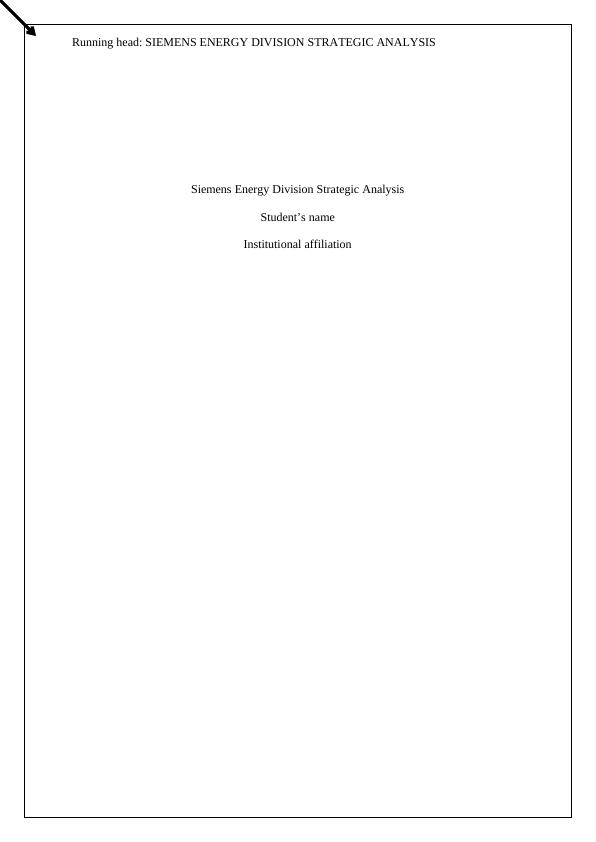
SIEMENS ENERGY DIVISION STRATEGIC ANALYSIS Executive SummaryRenewable energy has become the new front of the competition in the wake of climate change. Companies and governments are increasingly focusing on environmentally friendly energy sources. Siemens is a longstanding player in the energy sector and it has responded to this emerging need accordingly. This paper demonstrates the efforts of Siemens in maintaining its global footprints through renewable energy products and services. As an international company, it is expanding its operations into nearly every market in the world. However, the UK has remained the most viable investment destination because of the continued political goodwill to invest in the renewable energy sources like wind. The paper indicates that the firm embraces transnational and global efficiency strategy to achieve its business goal. The paper also demonstrates how the firm is customizing its rotor to serve different markets depending on the location thus increasing its profitability through offshore and onshore businesses.The paper has also responded to the gray areas like why the firm is going green. The driving factor evident in the paper is the Paris Agreement or Accord that has compelled countries andbusiness to comply with their emission limits or engage in carbon credit. It also highlights thestrategies that company can use to cut cost and increase profitability. The unique selling points of Siemens' wind power division have also been covering. Finally, the paper has highlighted Siemens offshore and onshore business and given relevant recommendations that can boost the company's market position.
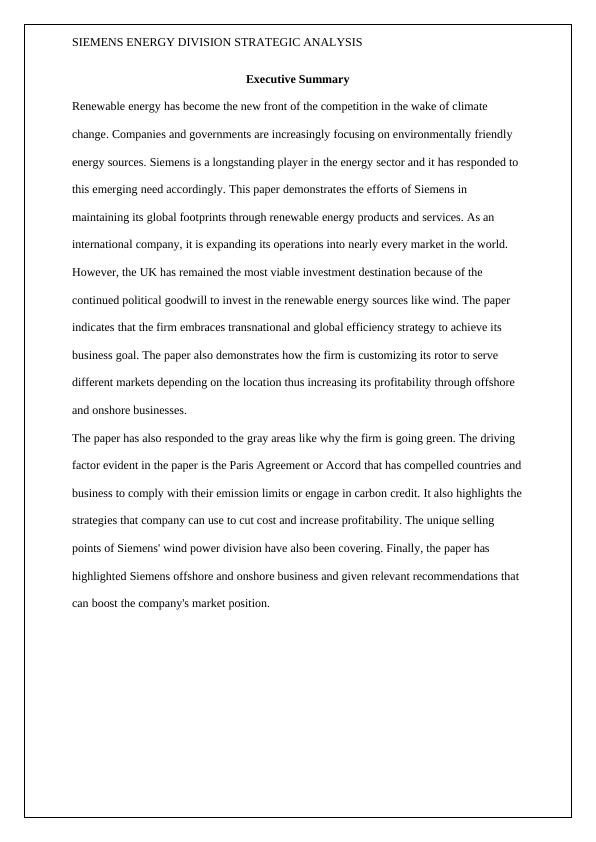
SIEMENS ENERGY DIVISION STRATEGIC ANALYSIS ContentsExecutive Summary...................................................................................................................iiIntroduction................................................................................................................................1How to structure the organization..............................................................................................1Porter’s Five Forces...................................................................................................................2Degree of rivalry.....................................................................................................................2Bargaining power of customers..............................................................................................2Bargaining power of suppliers................................................................................................2Threat of new entrants............................................................................................................3Threat of substitutes...............................................................................................................3Country Attractiveness Model of UK........................................................................................3How to transform Siemens wind power division using the BCG Matrix..................................4Do they customize the rotor for different markets.....................................................................4Increasing Profitability...........................................................................................................5Project in the UK (Humber).......................................................................................................6Why green energy......................................................................................................................6How to reduce cost and increase profit......................................................................................8What is Siemens wind power division unique selling point (USP)?.........................................8Gamesa-Siemens merger........................................................................................................8Research and Development....................................................................................................9One-stop-solution.................................................................................................................10High experience....................................................................................................................11Huge MNC, global presence................................................................................................11Off-Shore and Onshore Business.............................................................................................11Offshore................................................................................................................................11Onshore.................................................................................................................................12Conclusion................................................................................................................................13Recommendations....................................................................................................................13Reference..................................................................................................................................16Appendices...............................................................................................................................20Appendix 1: Siemens rotor blades........................................................................................20
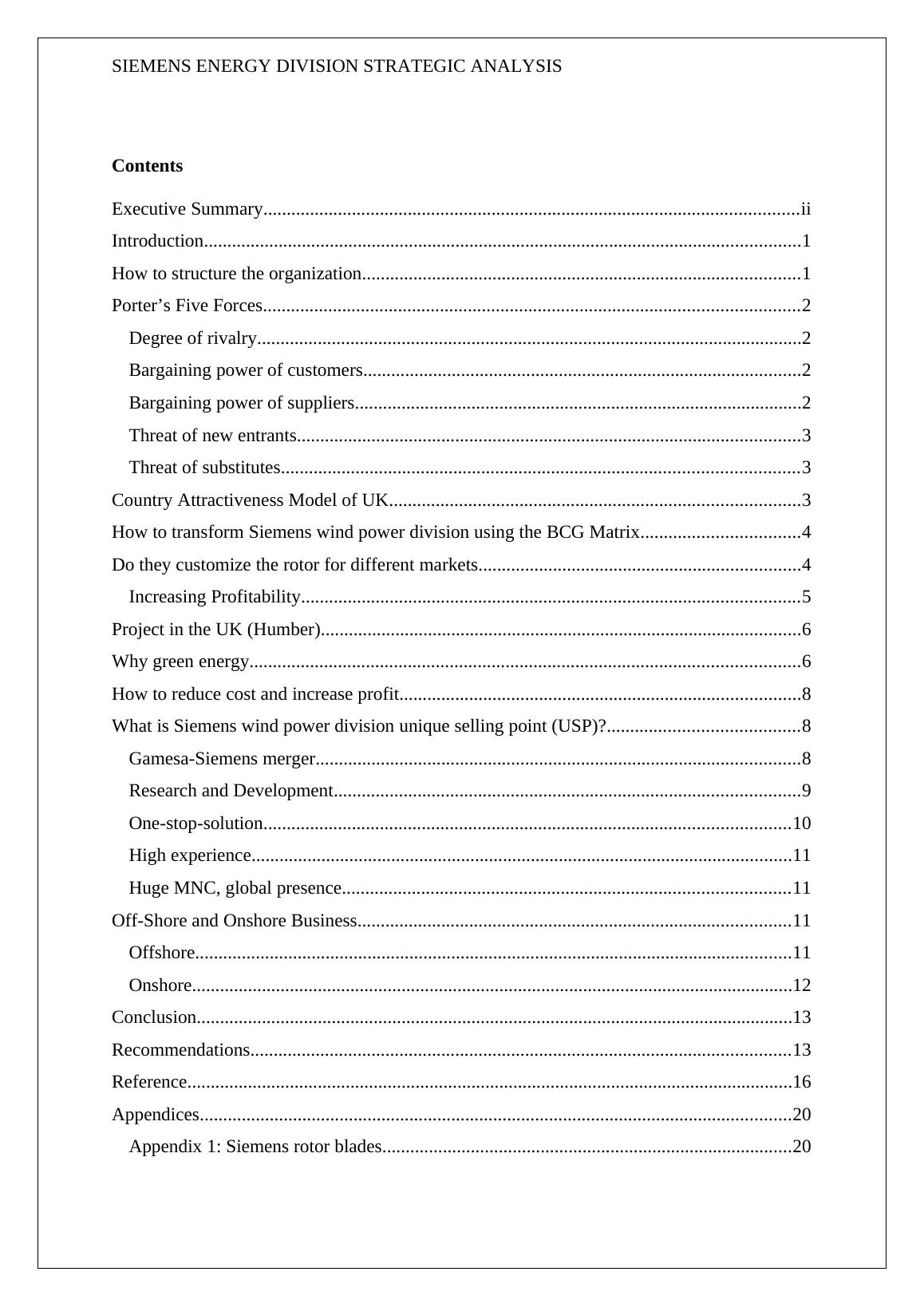
Siemens Energy Division Strategic AnalysisIntroductionSiemens is a leading global company that focuses on in-vitro diagnostics, medical imaging, and electrification value chain. The German company is a technology organization pursuing engineering excellence, corporate citizenship, and innovation. According to the company, it has established the long-term goals founded on digitalization, automation, and electrification. Siemens operates in four industries including energy, healthcare, infrastructureand cities, and industry (Kis-Orca, 2017). Siemens also has global positioning aspects that have enabled it to gain global footprint. For instance, it operates in Europe, Russia, China, theU.S, Africa, Brazil, India, and the Middle East. Based on this paper, there are different countries, which Siemens need to concentrate to boost its renewable energy production. The UK, the US, Canada, China, and Australia are among the countries that offer the organizationgrowth potential. However, the company's operations in the UK have proved profitable as demonstrated in this analysis.How to structure the organization The company has continuously used various international strategies to remain competitive in the market. The transnational strategy is one of the strategies the company uses to achieve local responsiveness and global efficiency. Similarly, it remains globally managed thus ensures its products remain standardized across its markets. According to the company's financial report, Siemens is an international company whose activities are evident in nearly all countries (Siemens, 2016). The technology company operates in the digitalization, automation, and electrification fields. In an effort to insert its authority and gain global footprint, Siemens has opted for mergers and acquisitions. For instance, its recent merger agreement with Gamesa will help to improve its business activities across the world.

SIEMENS ENERGY DIVISION STRATEGIC ANALYSIS As an international company, Siemens will always strive to locate its factories in the market with growth potentials. For instance, the emerging markets with high demand for green energy would attract the firm’s establishment. Today, with the Paris Agreement, many countries are investing in renewable energy thus reduce carbon emissions (Siemens, 2016). The firm’s wind turbines are gaining popularity as they replace the non-renewable energy sources. Siemens is thus seeking opportunities in these countries to increase its revenues. Given the current government support and goodwill in the UK, Siemens should establish its factories and R&D in the UK (Kis-Orca, 2017). This guarantees the firm the best opportunity to grow.Porter’s Five ForcesDegree of rivalryThe rate of rivalry in this industry is high because many manufacturers use sophisticated technologies to serve the interests of customers (Siemens, 2016). The companies use competitive prices outwit their rivals. For Siemens, its offshore turbines confirm the firm’s experience and technology to meet the market demands.Bargaining power of customersThe buyers in this industry have low bargaining power because the companies serve many consumers with extreme demand for the environmentally friendly products (Siemens, 2016). Siemens can serve different markets depending on its components thus making the powers of buyers to be medium.Bargaining power of suppliersThe suppliers’ bargaining power in this industry is low because some subcomponents are produced from a single firm as demonstrated by Siemens (2016). To this effect, Siemens can have the opportunity to increase its self-produced components.
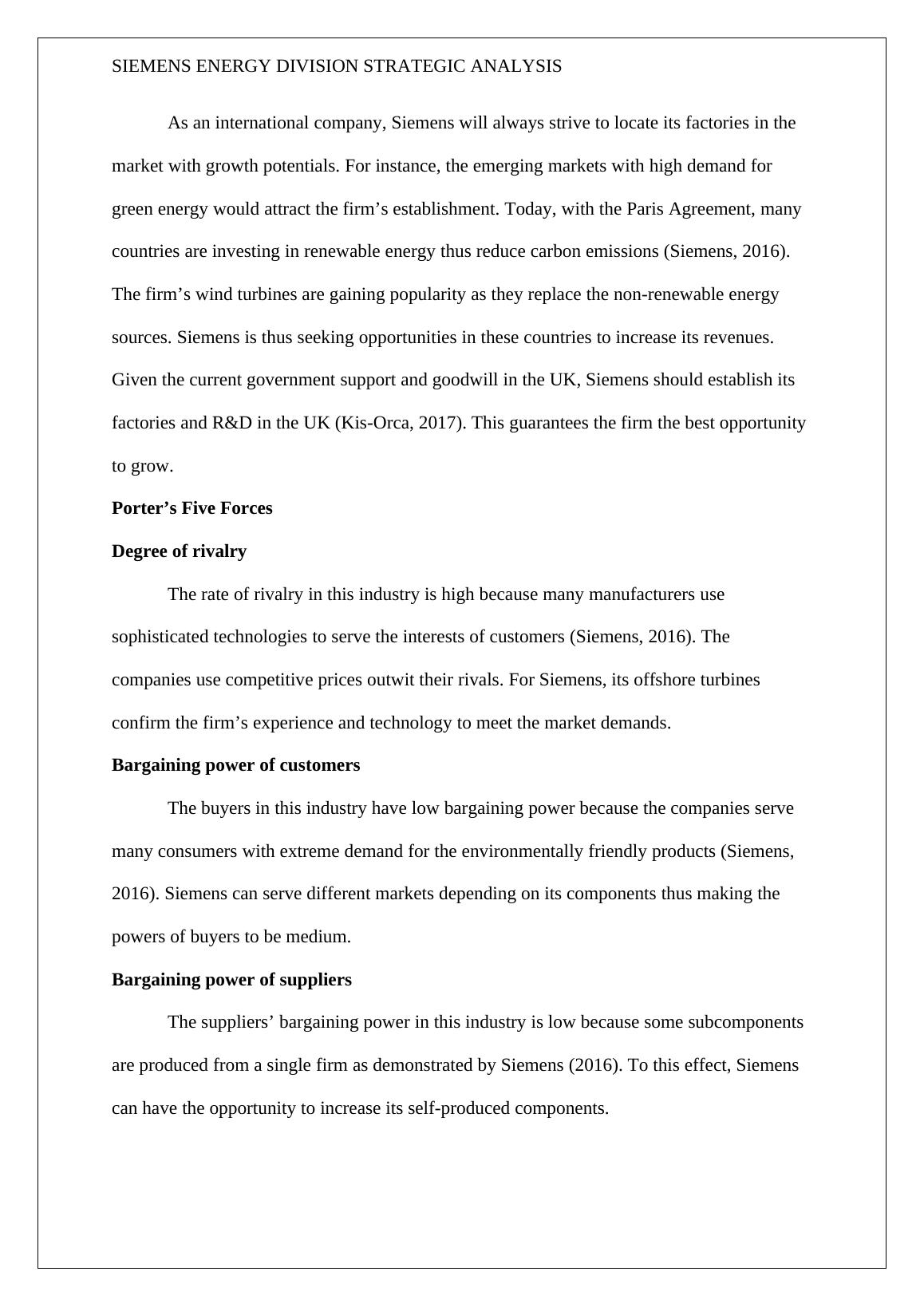
SIEMENS ENERGY DIVISION STRATEGIC ANALYSIS Threat of new entrantsThe barriers to entry in this market are high because the investment required for new entrants is high. This makes the potential new competitors to be low (Siemens, 2016). The renewable energy is a market with potential profitability. To this effect, Siemens stands to benefit by investing in this new sector.Threat of substitutesIn this industry, the competition from substitutes is medium. This is because; electrical energy generated from various conventional power plants assures the country of a higher power quality and reliability (Siemens, 2016). The cost of production is also lower than the conventional sector.Country Attractiveness Model of UKThe United Kingdom is among the few countries that have demonstrated the potential of the electricity consumption (EY, 2013). Based on its revised electricity consumption, the UK comes fourth. The power off-take is high thus provides Siemens an opportunity to increase its revenues. Regarding the macro drivers in the UK market, the country enjoys high macro stability and offers the ease of doing business. The country’s overall renewable index stands at 67. The UK government has further prioritized renewable energy thus banks on the industry for its future energy consumption. Compared to other countries, the UK has high technology-specific drivers (EY, 2013). Reuvid (2016) has also noted that the UK is among the leading countries in offshore wind. This follows the continued support offered by the government to attract investors. This has made the UK the most attractive destination for renewable energy investment. The country’s “Contracts for Difference (CfDs)” (EY, 2017, p.3) shows that the government will offer $943 million towards the auctioning of the renewableenergy. The government remains committed to the renewable industry thus attract investors
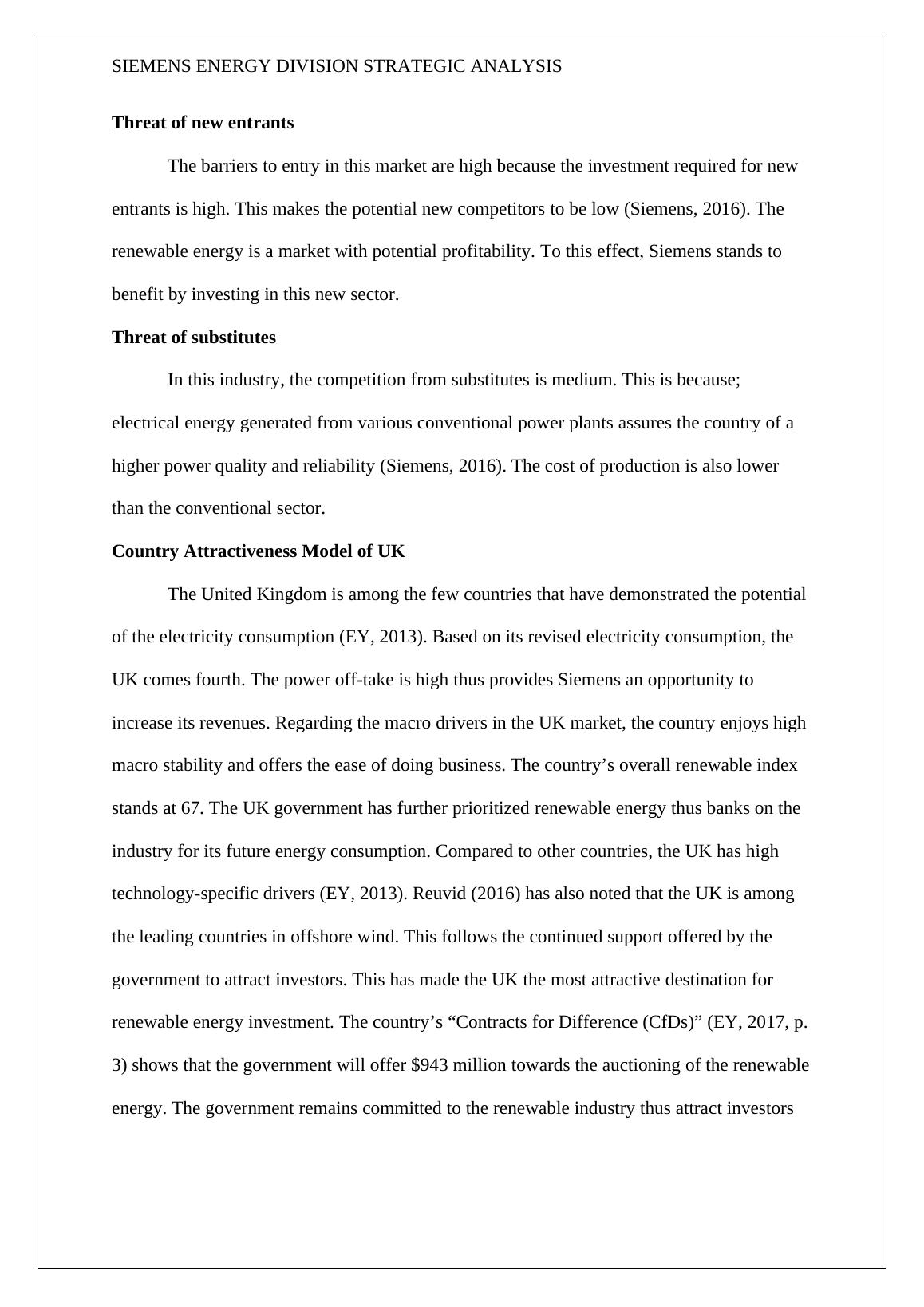
End of preview
Want to access all the pages? Upload your documents or become a member.
Related Documents
Renewable Sources of Energylg...
|20
|5322
|29
Issues in Global Business - Siemens Windlg...
|16
|5380
|47
Issues in Global Business and Strategiclg...
|21
|4657
|42
Issues in Global Business and Strategic Concepts - Siemenslg...
|13
|4364
|39
Designs and Strategies for Organizational Changelg...
|11
|2786
|124
De Montfort University - Assignment Solutionlg...
|17
|5734
|73
